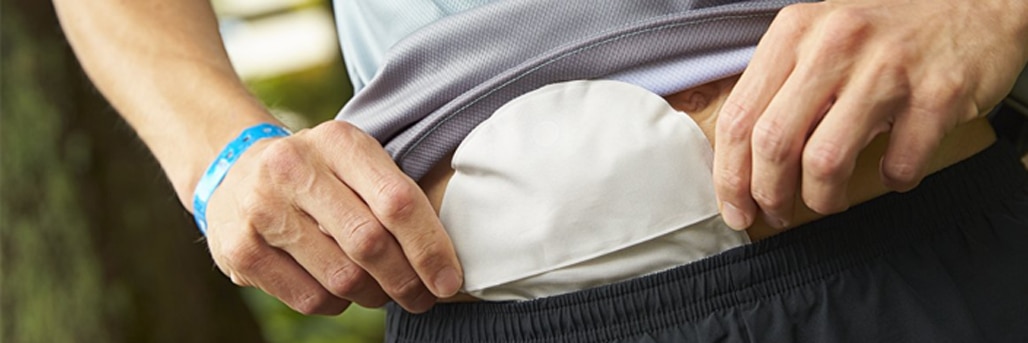
After stoma surgery
Learn more about looking after your stoma within the first three months after surgery.
The days after stoma surgery can be challenging. You have a pouch attached to your abdomen and lots of new things to learn. It's important to remember that it takes time to adjust, but it will get easier. With support from your stoma care nurse and practical guidance on how to change your ostomy pouch and care for your skin, you should soon be able to do the things you’ve always done.
In this section, you’ll find information that is intended to guide you as you become used to your stoma, up to the first 3 months after surgery. As well as information on managing your stoma, you’ll find helpful tips, keeping your skin healthy and other aspects of getting used to your stoma.
Getting used to your stoma
Taking good care of your skin
Keeping the skin around your stoma in good condition is the most important thing you can do to make life with a stoma pouch secure, comfortable and worry-free.
What will the stoma look and feel like after surgery?
When you wake up after the operation you’ll be wearing your first pouch. This will probably be a clear one so that your nurses can check on your new stoma easily. You may also have drips and drains attached to your body. This is perfectly normal and they will be removed with very little discomfort when appropriate.
Your stoma will be moist and pinkish-red in colour and should protrude from your abdomen. It may be quite swollen to begin with but will reduce in size over time – usually 6 to 8 weeks after surgery. A stoma is red in colour. This is because it is a mucous membrane, just like the mucous membrane inside your mouth. There is no sensation in the stoma, so it is not at all painful to touch. The stoma can bleed a little when being cleaned, especially in the beginning, but this is quite normal, and should stop shortly afterwards.
Your stoma will begin to work shortly after your operation, usually within a few days. At first the output will be a watery liquid and may be strong-smelling as your bowel hasn’t been working for a while. Don’t worry, though, the consistency will thicken slightly and the smell will diminish as you resume a more balanced diet. Your doctor will advise you when you will be able to eat and drink as usual.
Initially, it’s also likely that a certain amount of noisy wind will come from the stoma – again this is perfectly normal. It is not uncommon to feel the need to go to the toilet as you did before. This is normal and should reduce with time. If your anus is still present there may be some mucus discharge from it.
If you have a urostomy, the stoma will begin to work immediately after your operation. The tubes placed in the urostomy will be left in place for seven to ten days. At first, your urine may be tinged red, but it will soon return to its usual colour.

How do I learn about adjusting to life with a stoma?
Your stoma care nurse will explain how to take care of your stoma while you’re still in hospital. There’s a lot of information to take in, so don’t be afraid to ask questions.
After your operation, your stoma care nurse will focus on helping you become confident in taking care of your stoma. It will help to have a close relative or spouse with you for this training.
Your nurse will help you with:
- Learning how to care for your stoma, including what to watch out for
- Re-ordering stoma pouches and supporting products
- Your rights regarding reimbursement and other economic support relating to your stoma
- Other practical aspects of living with a stoma, e.g. foods and drink, your social life, travelling and your intimate relationships
- Who to contact when you have questions
- Ostomy associations in your area
Ask questions
There will be a lot of new information to take in at once; it may even feel a bit overwhelming. Take your time and ask all the questions you need, as many times as you need to. The more you ask and try things out, the better prepared you will be once you are back at home.
Before you leave hospital, your stoma care nurse will make arrangements for a follow-up consultation to make sure you feel confident caring for your stoma.
Overcoming challenges
Once you are home, you may experience some challenges caring for your stoma. But remember that your stoma care nurse, as well as Customer Care will be more than happy to help you with any issues.

Who to tell, and what to say about your stoma
After your operation, one of the big questions may be: how and who do I tell about my stoma?
Whoever you decide to tell, the most important thing is that you are comfortable with your decision. You may want to explain that you had major surgery because of a serious illness and now wear a stoma pouch. This often leaves few other questions to be asked and people will see that you have a straightforward attitude towards your condition.
Family and friends
Being open and honest with the people close to you can help you get back to the life you had before your stoma surgery. In the beginning, it’s important for the people closest to you to understand that although you are back home, recovery from major surgery will take time.
Children
If you have young children or grandchildren you may feel that they are too young to understand. However, children tend to cope well if they are given the information in a simple way. Children will often pick up on secrets and hiding the truth from them can sometimes make them think a situation is more serious than it really is.
At work
Many people are concerned about telling work colleagues. And just like with family and friends, who you tell and what you tell them is entirely up to you. However it’s usually advisable to ensure that at least one person knows you have a stoma. Then, in case there are any problems or issues, you will have someone to talk to.
Stoma appliance terms explained
Life after stoma surgery is a journey, with challenges along the way. Here we provide you with some of the explanations of stoma appliance terminology you may come across.
To help you better understand your stoma appliance and discuss your needs with your stoma care nurse, here is a glossary of commonly used terms.
Adhesive: The part of a stoma appliance that attaches the appliance to your skin while you are wearing it. The adhesive must ensure close contact with the skin surface so that output from your stoma does not touch the surrounding skin.
Baseplate: The part of a two-piece stoma appliance that is covered by the adhesive.
Coupling system: This attaches the adhesive baseplate to the pouch in a two-piece appliance, allowing the pouch to be changed without changing the baseplate. It can either be mechanical, or adhesive.
Convexity: A specially shaped baseplate with an oval shell that puts light pressure on the peristomal skin. It is designed to help pouch a stoma that is difficult to manage, for example, a retracted stoma that lies below the skin.
Extended wear adhesive: An adhesive that can be worn for a longer time period, or if there is “aggressive” output from your stoma. Some types of ileostomy or urostomy can have output that breaks down standard adhesives too quickly. Extended wear adhesives are generally used with two-piece appliances.
Filter: From time to time, your stoma releases flatus or wind. The filter included in the appliance has a deodorising action which helps ensure there is no odour, one of the things that people often worry about. It also controls the release of the deodorised wind, so that your bag doesn’t inflate (which is also called ‘ballooning’).
Non-return valve: Urostomy appliances have a non-return valve to stop urine from flowing back to the stoma and help prevent urinary infections.

How can Coloplast Care make a difference for you?
- Reliable advice, whenever you need it
- Supplement the education and advice you get from your stoma care nurse
- Guidance on selecting the right products
- Easy access to samples of relevant products
- Free home visits by Coloplast Stoma Care nurses
Life with an ostomy isn't always straightforward. So why go it alone?
